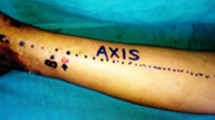Abstract
Background
Very few flaps described in the literature would be as versatile as the reverse sural flap. In spite of its few shortcomings, it is one of the most widely used flaps for lower third defects in the leg because of the paucity of tissues in the region. In a lot of situations, free tissue transfer is the only feasible option because of non-availability of local options in the involved limb. In such a scenario, a reverse sural flap from the contralateral leg can be manoeuvred in a cross leg fashion as an alternative to free flap. It employs skin and soft tissue from the opposite limb which can easily cover large defects in the lateral malleolar and tendoachilles region which would be unachievable with a traditional cross leg flap.
Methods
A prospective study was developed from September 2018 to March 2020 at SMS Hospital, Jaipur. A total of 10 patients underwent flap cover. Rigid fixation with the help of external fixator was used to prevent flap avulsion, and flaps were divided at 3 weeks.
Results
All cases were done in 2 stages, fixed with external fixator and divided at 3 weeks. All 10 flaps survived without any flap failure. One flap had ischaemic changes in the distal most part of the flap which was later debrided and flap advanced to cover the defect. Successful coverage of defect was achieved in all 10 patients, and donor site healed uneventfully.
Conclusions
In our experience, a reverse flow cross leg sural flap is a significant option for leg defects where there is a paucity of nearby tissues for stable flap cover and as an alternative to free flap. It is an excellent option for covering large defects over the lateral side of the leg where a traditional cross leg flap cannot reach. It can also circumvent the use of free flaps in patients who cannot undergo a long duration surgery. The relative simplicity of this flap makes it a very useful flap for large defects of the lower third of leg.
Level of evidence: Level IV, therapeutic study.



Similar content being viewed by others
References
Devansh S (1995) Prefabricated recipient vascular pedicle for free composite-tissue transfer in the chronic stage of severe leg trauma. Plast Reconstr Surg 96:392–399
Chen H, El-Gammal TA, Wei F et al (1997) Cross-leg free flaps for difficult cases of leg defects: indications, pitfalls, and long-term results. J Trauma 43:486–491
Tan BK, Wong CH (2009) An anomalous septocutaneous perforator to the skin paddle of the fibula osteocutaneous flap originating from the posterior tibial artery. J Plast Reconstr Aesthet Surg 62:690–692
Mok WL, Por YC, Tan BK (2014) Distally based sural artery adipofascial flap based on a single sural nerve branch: anatomy and clinical applications. Arch Plast Surg 41:709–715
Musharafieh R, Atiyeh B, Macari G, Haidar R (2001) Radial forearm fasciocutaneous free-tissue transfer in ankle and foot reconstruction: review of 17 cases. J Reconstr Microsurg 17(3):147–150
Fraccalvieri M, Verna G, Dolcet M, Fava R, Rivarossa A, Robotti E, Bruschi S (2000 Aug) The distally based superficial sural flap: our experience in reconstructing the lower leg and foot. Ann Plast Surg 45(2):132–139
Stark RB (1952) The cross leg flap procedure. Plast Reconstr Surg 9:173–204
Calhoun JH, Gogan WJ, Beraja V, Howard RJ, Oliphant JR (1989) Dynamic axial fixation for immobilization of cross-leg flaps in chronic osteomyelitis. Ann Plast Surg 23:354–356
Barclay TL, Sharpe DT, Chisholm EM (1983) Cross-leg fasciocutaneous flaps. Plast Reconstr Surg 72:843–847
Atiyeh BSMD, Al-Amm CAMD, El-Musa KAMD, Sawwaf AWMD, Musharafieh RSMD (2003) Distally based sural fasciocutaneous cross-leg flap: a new application of an old procedure. Plast Reconstr Surg 111(4):1470–1474
Mojallal A, Wong C, Shipkov C, Bailey S, Rohrich RJ, Saint-Cyr M, Brown SA (2010) Vascular supply of the distally based superficial sural artery flap: surgical safe zones based on component analysis using three-dimensional computed tomographic angiography. Plast Reconstr Surg 126:1240–1252
Liang W, Tan B (2019) Use of the cross-leg distally based sural artery flap for the reconstruction of complex lower extremity defects. Arch Plast Surg 46:255–261
Al-Qattan MM (2001) A modified technique for harvesting the reverse sural artery flap from the upper part of the leg: inclusion of a gastrocnemius muscle "cuff" around the sural pedicle. Ann Plast Surg 47(3):269–274 discussion 274-8
Al-Qattan MM (2005) Lower-limb reconstruction utilizing the reverse sural artery flap-gastrocnemius muscle cuff technique. Ann Plast Surg 55(2):174–178
Author information
Authors and Affiliations
Corresponding author
Ethics declarations
Ethical approval
All procedures performed in studies involving human participants were in accordance with the ethical standards of the institutional and/or national research committee and with the 1964 Helsinki Declaration and its later amendments or comparable ethical standards. The study was conducted after getting adequate ethical clearance from the ethical committee of our organisation.
Informed consent
Informed consent was obtained from all individual participants included in the study.
Patient consent
Patients signed informed consent regarding publishing their data and photographs.
Conflict of interest
Kushal Monga and Pradeep Gupta declare no conflict of interest.
Additional information
Publisher’s note
Springer Nature remains neutral with regard to jurisdictional claims in published maps and institutional affiliations.
Rights and permissions
About this article
Cite this article
Monga, K., Gupta, P. Reverse flow cross leg sural flap as a reconstructive option for traumatic defects in the lower leg circumventing free flaps. Eur J Plast Surg 44, 813–816 (2021). https://doi.org/10.1007/s00238-021-01806-4
Received:
Accepted:
Published:
Issue Date:
DOI: https://doi.org/10.1007/s00238-021-01806-4




